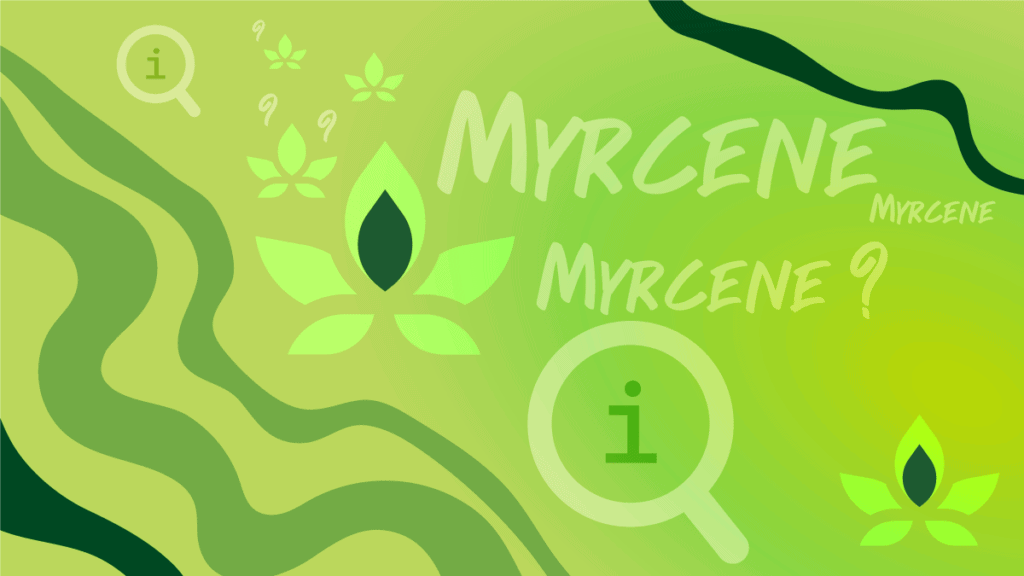- Dispensaries
-
Cultivars
By Cultivar Types
By Effects
By Terpenes
- Blog & Press
- About
- Products
What is Myrcene? Cannabis Terpene Explained
- Cenk Cetin
- April 1, 2024
- 2:59 pm
- No Comments

Introduction
Terpenes, as discussed in our articles on caryophyllene and limonene, are very important compounds in nature. They are responsible for aromas, pigments and therapeutic effects of many plants including cannabis.
Myrcene is one of the most common terpenes in nature, on a similar level to caryophyllene but not quite as common as pinene. It is found in hops, mango, lemongrass and a number of other herbs. There is a distinct pleasant fresh “green” aroma to myrcene that is comforting as simply aromatherapy. It is also known for being natures’ sleepy terpene as well as being incorporated into various cosmetic and wellness products.
Myrcene is actually the most abundant terpene found in modern cannabis plants across the globe. It has a pleasant earthy herby odour that has fresh fruity notes. Myrcene is one of the most sedative terpenes and is believed to have a very significant effect on the experience of a cultivar. Below is the percentage of strains dominant in each terpene.
Myrcene in nature and culture
Myrcene is found in over 200 plant species producing a sweet, earthy pleasant smell. It, like most terpenes, has many natural purposes such as antimicrobial support and to help regulate the stress of the plant with shifting environmental conditions.
Lemongrass is a common source of naturally occurring myrcene, it has been a large part of the diet where it is native and now is used world wide. It also was used in traditional medicine for purposes such as helping with stomach pain and infections.
Bay leaves, thyme, and parsley are all sources of myrcene and they are integral to many cultures’ cuisine and are also used worldwide. These herbs are sought after by chiefs around the world and are household necessities for families where they locally grow.
Myrcene is also present in mangos, melons and guava. Many fruits have a host of health benefits, but they also have their spectrum of effects. Fruits with myrcene can be amazing for gut health, hair health, cholesterol regulation and blood pressure.
Myrcene is also responsible for much of the taste of beer. This is due to its synergistic effect with essential oils in hops such as linalool, another terpene also found in cannabis. Hops are actually a very close relative to cannabis, they are both in the cannabaceae family and both have myrcene as their most abundant terpene.
Myrrh, the ancient traditional medicine, is where the terpene actually gets its name. It was (and still is) used as a painkiller, disinfectant, muscle relaxant, and anti-inflammatory in Chinese and Middle Eastern medicine for thousands of years. It is derived from the commiphora genus of plants that grow naturally from the south Pacific to tropical Africa. Myrrh’s health benefits come from the combined effects of other terpenes such as caryophyllene, limonene and pinene among others.
Ref: article, article, article
Myrcene – in detail
The myrcene usually referred to is actually beta-myrcene. There are two distinct isomers of myrcene with beta-myrcene having a bit more research done on it. They are both a-cyclic monoterpenes, meaning they have no ring of particles and no oxygen molecule in its chemical structure
Alpha-myrcene is also found in hops, mangos and others but has more of an earthy spicy aroma. Alpha-myrcene is also a therapeutic terpene in its own right, but is not as widely isolated as its counterpart. There is still much more scientific research to be done on all terpenes!
When isolating myrcene for industrial use, manufacturers can extract myrcene from pinene. A process called pyrolysis is used to break apart the pinene. Pyrolysis is a process to break down particles with heat, for example wood into charcoal. There are intentions for the future to produce microbial extraction methods for large scale production of myrcene.
Myrcene Health benefits
Myrcene is extremely bioavailable, meaning the body easily absorbs it into the bloodstream. The mood elevating effects can be felt within five minutes of inhaling.
Also myrcene reaches the blood without breaking down which increases its effectiveness. These biological functions are thought to be responsible for a lot of myrcene’s potency and prevalence in the food, beverage and wellness industries.
Myrcene, like many terpenes, has anti-inflammatory, pain killing and sedative qualities. These effects are some of the more common desirable therapeutic aims for wellness.
Inflammation can be caused by many things and have many different expressions. Stress or exhaustion can cause inflammation that can be more chronic than an allergic reaction for example. This can express itself through various conditions like arthritis and heart problems. Myrcene can help reduce symptoms of inflammation and help with overall heart health.
Anxiolytic, or anti-anxiety, medication without side effects is in high demand around the world. Anxiety can cause stress leading to inflammation, but also insomnia, delirium and a deterioration of physical health. Myrcene is therefore an effective aid in regulating the nervous system. This regulation means that myrcene is also a significant anticonvulsant agent and can be a great addition to seizure medication.
Myrcene is also a great gastro protector and antioxidant. Gastro-protection improves gut health and can help with conditions like crohn’s disease. Therefore myrcene helps with overall metabolic harmony and internal inflammation. Antioxidants can reduce risk and effect of many conditions such as heart problems and diabetes. This aspect of myrcene is growing in interest in the food and beverage and wellness industry.
Myrcene used in wellness
For aromatherapy, Lemongrass essential oil, which is about 15-20% myrcene, can be used to significant effect. It has a strong painkiller effect without tolerance build up and can be used topically when diluted or inhaled for direct effects.
Myrcene can be implemented into your diet quite easily, especially in places like Thailand where lemongrass is a very common culinary ingredient and traditional medicine. Having a full spice rack to optimise your terpene consumption will surely help your overall wellness.
Fruits containing myrcene are delicious additions to your wellness routine and help with things like gut health and blood pressure. Beer isn’t the most recommended wellness product, however organic “hoppy” beers, high in myrcene, in moderation can improve mood and stress levels with little side effects.
When consuming myrcene in cannabis it is helpful to understand the quantity of myrcene in the strain as it will have a strong influence on the relaxing nature of the experience. A strain with more than 0.5% myrcene is said to be sedative and a myrcene content below 0.5% will allow the other terpenes and cannabinoids more influence on the experience.
Therefore, high myrcene cultivars are what’s known as pro-anabolic, meaning they support anabolic states of the body more associated with sleep and rebuilding of tissue and neurons. This means that myrcene is not the best in the morning as it can reduce your energy levels. Lower myrcene content, and a higher limonene content for example will produce a pro-catabolic strain meaning it is more suitable to waking and alertness.
High Myrcene Cultivars
Northern Lights is a myrcene heavy strain that is very popular with medical marijuana consumers for its particularly effective sedation and relaxation effects. Produced by breeding Afghani indica and Thai sativa landraces, yet maintaining a heavy resinous indica character. Perfect for the end of a hard day.
Permanent Marker has become a modern classic hybrid and is high in myrcene. It is known for being gassy and pungent with its spicy flavoursome additions of pinene and caryophyllene. The dominant myrcene produces an overall calming and “tingly” experience that consumers love.
Conclusion
Myrcene is a very powerful terpene and we still have more to learn about its applications. From ancient painkillers to beer to modern smoothies, myrcene has been connected to human life for milenia.
Now with modern cannabis genetics and a global spice and wellness trade, myrcene is as abundant as it’s ever been on our planet. Scientists and botanists are evolving cannabis cultivars and our understanding of the compounds they produce in order to enhance our lives.
This opening up of cannabis science has allowed us to learn about how to optimise our own lives with pleasurable tastes, smells and experiences of not just cannabis but all the plants that share terpenes. There is far more to learn, but finding myrcene as the connection between mangos, beer and cannabis is a great illustration of how holistic wellness can be very pleasant and delicious!



